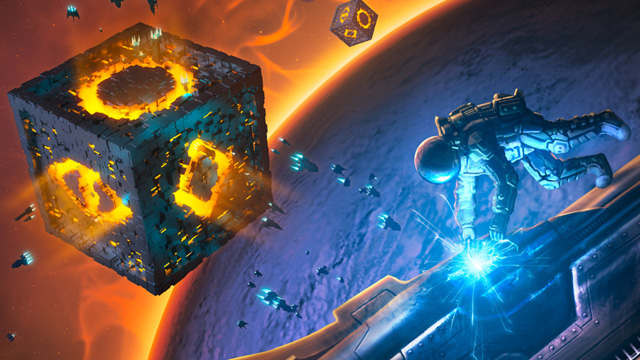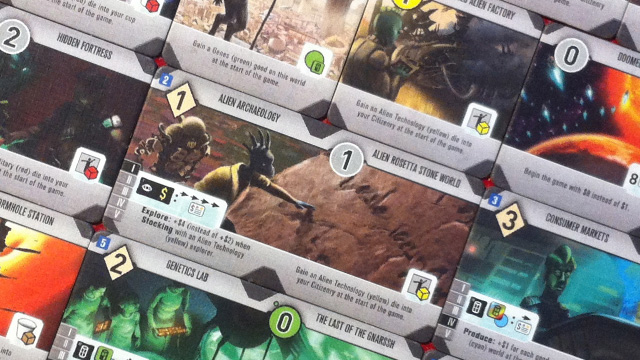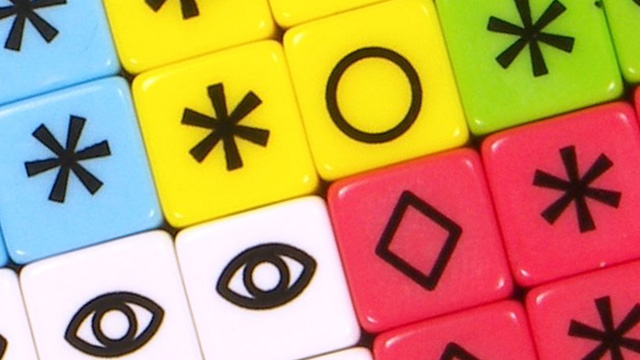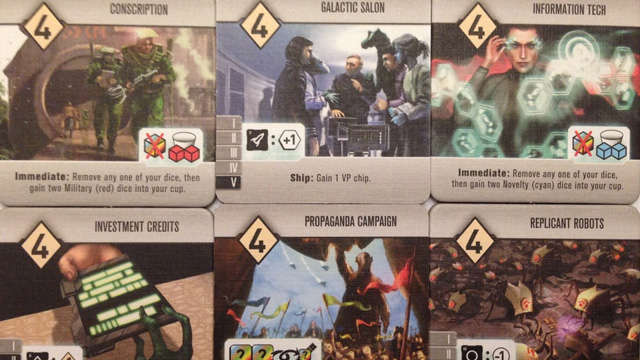
Race for the Galaxy is still one of my all-time favorite games, but I won’t deny that it has a fairly steep learning curve. It can be hard to teach to new players, especially after several expansions had fundamentally changed the game for me, making a stripped-down “base” game awkward for all involved. A new, streamlined start would be a better option, and that’s exactly what Roll for the Galaxy offers.
As might be implied by the title, Roll trades Race‘s cards for dice and tiles. Each player begins with five white “home” dice and whatever additional dice are indicated by their starting world and faction tiles. Each of the six different colors of dice is weighted towards its specialty. For example, “home” dice are general purpose with a slight bias towards exploration, red “military” dice emphasize developing and settling, and cyan “novelty” dice focus on production and shipping. All non-“home” dice also have at least one wild face.
Each turn, all players roll their available dice behind their screens. One die of your choice is used to select your phase for the turn, regardless of what phase that die actually rolled. Each remaining die is then assigned to its indicated phase as a worker. Worker dice may be reassigned by various abilities, including a once-per-turn “dictate” ability that is always available, so you aren’t completely at the mercy of your roll.

Explore dice are either used to obtain new tiles or to generate a stock of galactic credit for use later. Each tile represents a planet on one side and a development on the other, and you can select which side you want to work on freely. Developer and settler dice are then assigned to their respective “under construction” tile stacks. If the number of dice on the stack is equal to the cost of the topmost tile, that tile is placed on the player’s tableau; leftover dice remain on the stack for future construction or returned to the player’s cup if the stack is empty. Production dice are placed on empty world tiles to represent goods that are then sold via shipping dice.
The catch, of course, is that your workers only do their jobs if their phase is actually selected by someone. Any worker whose phase isn’t selected gets returned to their player’s cup instead. You can only guarantee one phase each turn, so you have to hope your opponents pick something different if you want to maximize your actions each turn. Being able to anticipate their selections is nice, but it’s even more important to realize that there will never be more selected phases than there are players in the game. If you roll four or five different phases in a three-player game, some of those dice are going to be wasted unless you reassign them or otherwise find a use for them. In a two-player game, a spare home die is rolled after both players have revealed their choices to represent a third selected phase… sometimes. (We call that die “the jerk,” for reasons you will quickly recognize if you play this way.)

Any worker that completes its task is returned to a holding pool called the citizenry. At the end of each turn, players can put one die of their choice from their citizenry into their cup for each unit of credit they have acquired through selling goods or other abilities. Players must buy back as many dice as they can. If this reduces them to zero credits, they then gain one credit to make sure they always have at least one die to roll each turn. This single die will just be used to select a phase, so its actual result is irrelevant, but it’s better than nothing. Players may also freely recall any workers currently assigned to construction stacks at this time, which is rare but sometimes you plan poorly and get stuck.
The game ends when one player has at least twelve tiles in their tableau (including the three each player begins with) or when the pool of VP chips is exhausted (via shipping actions), just like in the card version. Unlike the card version, each constructed tile is simply worth its cost in points instead of an assigned value. Six-point developments still exist, but now give bonus points on top of their inherent six instead of a variable amount.
The final major change from the card version is the elimination of two of the most confusing aspects of planets: military strength and windfall worlds. There is no longer a distinction between military and normal worlds, as all worlds are settled the same way. Windfall worlds still exist, although they are cleverly hidden in plain sight. When constructed, some worlds provide new dice directly to your cup (production worlds), while others have a die placed on them (windfalls). The best part of this is the fact that the only way you would ever recognize the difference is if you have experience with Race as unlike their cardstock counterparts they behave identically in all other aspects.

And that’s the beauty of Roll for the Galaxy. It is very much still Race, presented in a completely different way, but not unrecognizable if you have experience with the original. I have watched players who had difficulty grasping Race take to Roll almost immediately, hanging with Race veterans with ease. Although not necessarily outperforming them, I will add; many skills honed over the last six years or so — or even further back if you include Race ancestor Puerto Rico — are still applicable to this new permutation. There is still randomness, and more than in the card game, but not enough to completely fight good strategy.
If there is one flaw to Roll when compared to Race, it is time. An average game of Roll takes about 45 minutes. This is still a fast time compared to most other games, but experienced players could easily get in two or three games of Race in that same time. Having to assign (and possibly reassign) dice, pull double-sided tiles out of a bag, and choose which dice to buy back each turn all add to mechanical complexity that a simple deck of cards just doesn’t have. Roll also demands quite a bit more table space as players need room for their tableaus as well as room to roll and assign dice behind their screens. It isn’t as sprawling as a deep worker-placement game like Caverna, just not as compact as its ancestor.
Roll for the Galaxy retails for $60 thanks to including over 100 custom dice as well as some heavy-duty cardboard for the tiles. That seems like a lot up-front, but there are no plans for future expansions so in the long run it is probably less expensive than a “complete” Race for the Galaxy game. If you haven’t been able to get into Race but have wanted to, I highly recommend giving Roll a shot.



















